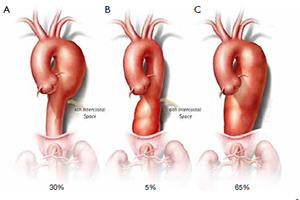Open repair of chronic complicated type B aortic dissection using the open distal technique
Abstract
Aim: The present study aimed to analyze early and late outcomes after open repair of chronic type B aortic dissection.
Methods: We retrospectively reviewed our cases of open descending thoracic aortic aneurysm (DTAA) with chronic dissection from 1991-2013. Long-term survival and aortic reinterventions were analyzed and patient comorbidities were evaluated in order to determine the risk of adverse outcomes. Furthermore, the technique for “distal first approach” is described.
Results: Between 1991 and 2013, 240 (40%) descending thoracic aortic repairs with associated chronic dissection were performed. Mean age is 59 years and 178 (74%) are men. The majority of patients (218, 91%) underwent repair using the adjunct of distal aortic perfusion with cerebral spinal fluid drainage. Early mortality was 8.3% (20/240). Permanent neurologic deficit occurred in 1.3% (3/240). Stroke occurred in 2.9% (7/240), and dialysis on discharge in 6% (12/240). 5-, 10-, 15-, and 20-year survival was 72%, 60%, 45%, and 39%, respectively. Freedom from reoperation on the operated segment was 97%, 94%, 94% and 94% at 5, 10, 15 and 20 years.
Conclusions: Open repairs of chronic descending thoracic dissections can be performed with respectable morbidity and mortality. Risk of neurologic deficit remains low with use of adjuncts, and risk of reintervention on the involved aortic segment is also low. These results allow comparison with endovascular repair for chronic aortic dissection.
Cover






